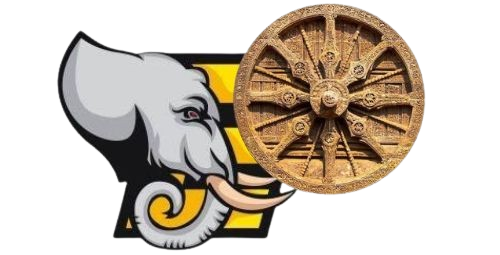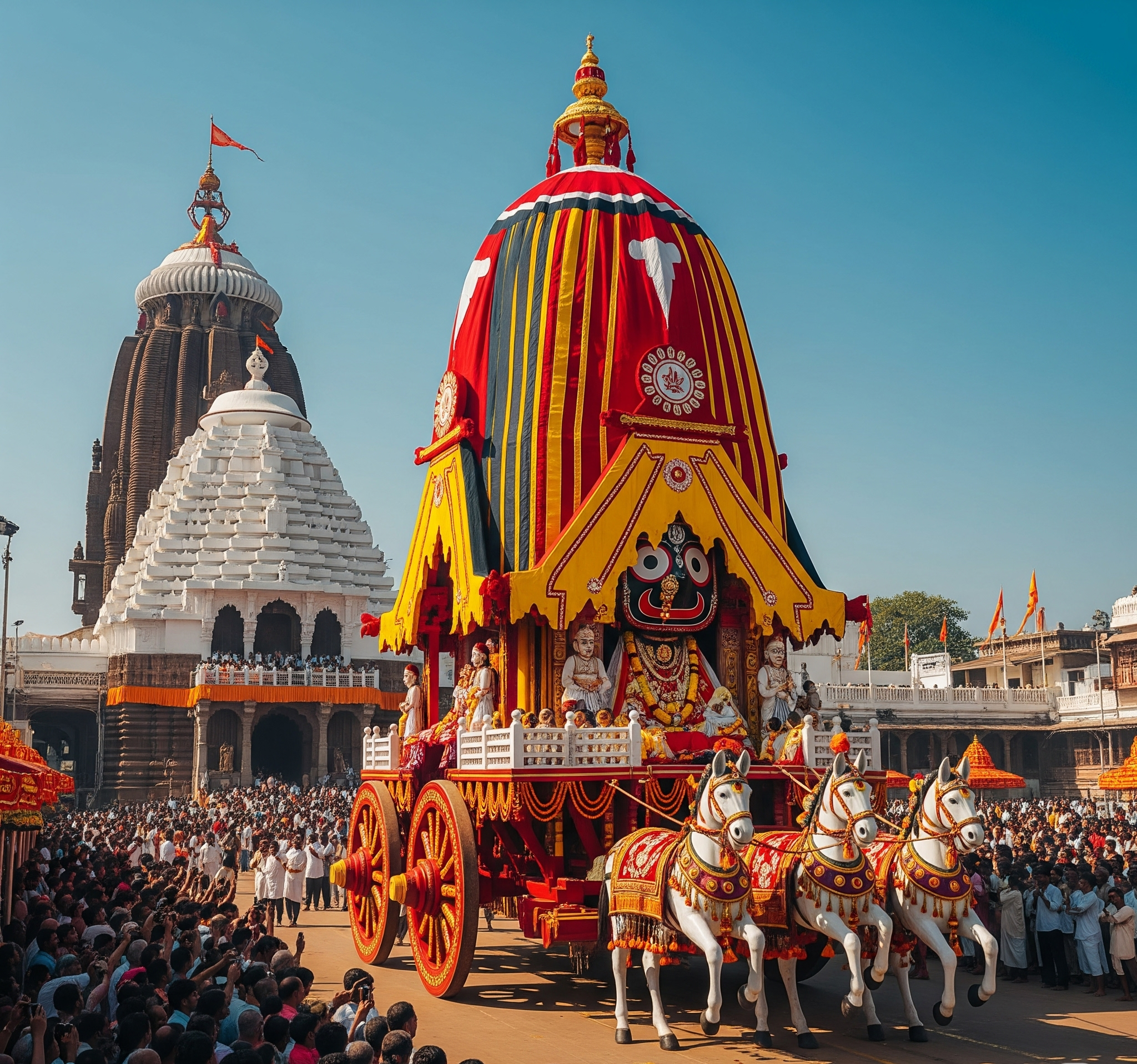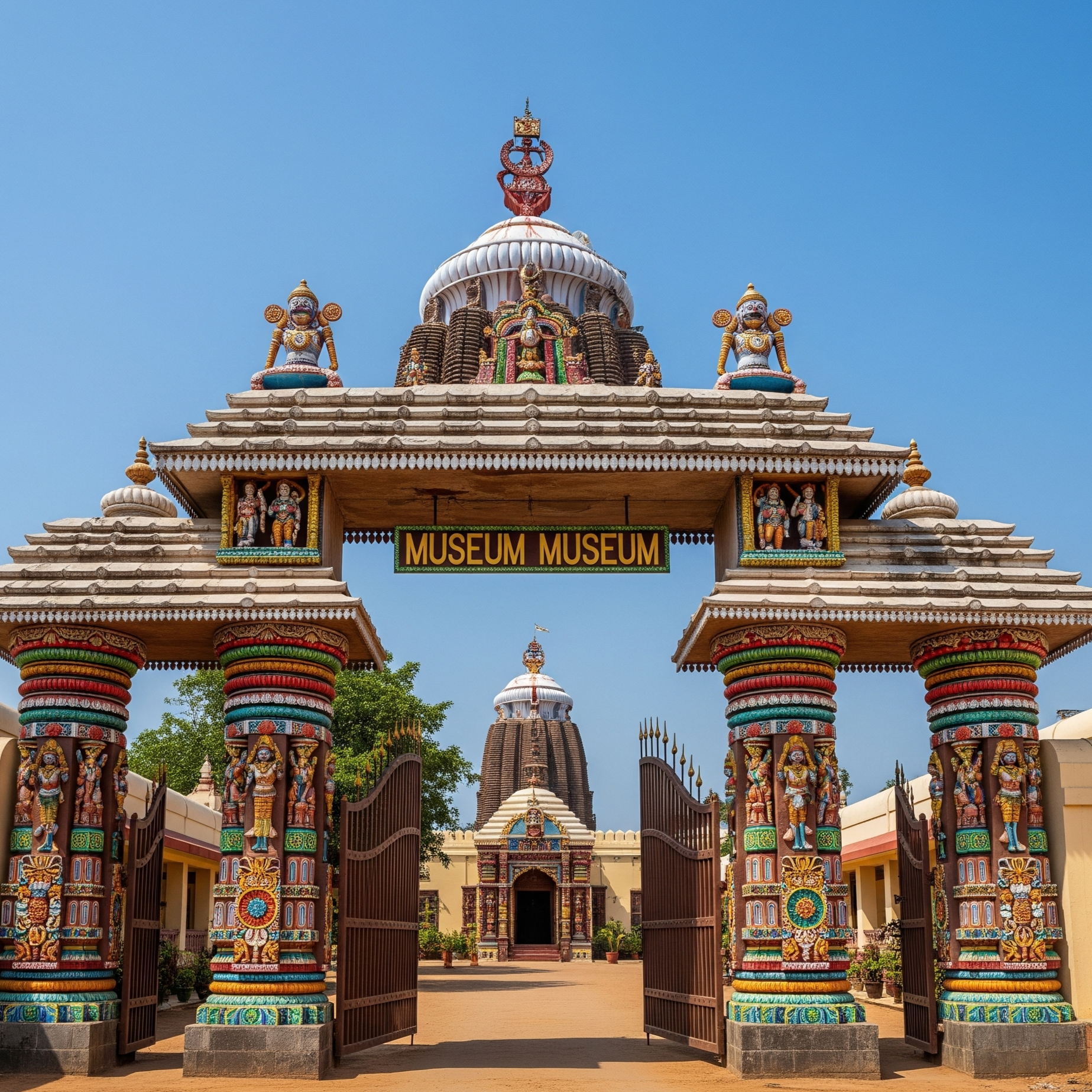Among the most iconic symbols of Odisha’s spiritual heritage, the chariot of Lord Jagannath, known as Nandighosa, holds immense religious, cultural, and artistic significance. It is not merely a vehicle—it is a sacred embodiment of cosmic power and divine tradition. Every year, during the Rath Yatra (Chariot Festival) in Puri, Odisha, millions witness the magnificent sight of three colossal chariots rolling through the Grand Road, carrying Lord Jagannath, his elder brother Balabhadra, and sister Subhadra to their garden retreat, the Gundicha Temple.
Among these, the Nandighosa chariot of Lord Jagannath stands tallest and most elaborately decorated, representing not just movement, but a journey of the soul, of time, and of divine energy.
The Meaning and Symbolism of Nandighosa
The name “Nandighosa” is derived from two Sanskrit words—“Nandi”, meaning joy or happiness, and “Ghosa”, meaning sound or voice. Together, it symbolizes “the sound of divine bliss”. This chariot is not just a structure—it is a manifestation of spiritual ecstasy, representing the journey of Lord Jagannath to bless His devotees beyond the sanctum of the temple.
Nandighosa is seen as a living, breathing deity during the Rath Yatra. It is revered not just for whom it carries but for what it represents: unity, mobility of the divine, and the breaking of all social and spiritual boundaries. During Rath Yatra, even those who are traditionally not allowed inside the temple—foreigners, Dalits, and non-Hindus—can have the darshan (holy view) of the Lord atop Nandighosa.
Origins of the Chariot Tradition
The tradition of building chariots for the Rath Yatra is believed to be over a thousand years old, dating back to the time when the Jagannath temple was constructed in the 12th century by King Anantavarman Chodaganga Deva of the Ganga dynasty. However, references to chariot festivals and the pulling of the Lord in processions can be found in much older Puranic texts and tribal traditions, particularly those associated with Lord Vishnu and Krishna.
Some scholars argue that the roots of this tradition are older than the temple itself, possibly inspired by indigenous and tribal rituals where wooden carts or idols were carried in ceremonial parades. Over centuries, this practice was absorbed into Vaishnavism and formalized as Rath Yatra in the Puri Jagannath tradition.
Construction of Nandighosa: A Sacred Art
The making of the Nandighosa chariot is not a construction project—it is a religious ritual in itself. The work begins on Akshaya Tritiya, an auspicious day in April or May, and is carried out by traditional temple artisans known as “Rathakars” (carpenters) who follow hereditary roles.
Key Details About Nandighosa:
- Deity: Lord Jagannath
- Height: Approximately 45 feet (13.7 meters)
- Width: Around 34 feet
- Wheels: 16 large wooden wheels, each about 6 feet in diameter
- Color: Red and Yellow, symbolic of power and purity
- Number of Wooden Components: Over 2500 individual parts
- Materials Used: Specially chosen neem wood (Daru), phassi and dhaura woods
- Decorations: Painted with mythological symbols, animal motifs, lotus flowers, and celestial emblems
The chariot is constructed entirely afresh every year, as per ancient guidelines found in palm-leaf manuscripts like the Silpa Shastra and the Purushottama Samhita. No nails or metal parts are used; the entire structure is held together using wooden pegs and ropes.
Divine Architecture: Symbolic Design of Nandighosa
The architecture of Nandighosa is loaded with cosmic and spiritual meaning:
- Nine levels or steps represent the nine planets (Navagraha).
- Canopy and flag (Pataka) symbolize the Lord’s divine protection and presence.
- Four horses—Shankha, Balahaka, Suweta, and Haridashwa—represent strength and celestial force.
- Charioteer Daruka symbolizes the connection between the divine and the devotee who drives the spiritual journey.
- The chakra (disc) on the top of Nandighosa symbolizes Vishnu’s Sudarshan Chakra, a mark of divine authority.
Each part of the chariot is aligned with a mantra, a deity, or a cosmic element. The chariot itself becomes a mobile temple, a divine vehicle that allows Lord Jagannath to bless devotees far from His sanctum.
Pulling the Chariot: A Ritual of Devotion
During the Rath Yatra, the massive chariot of Lord Jagannath is pulled by thousands of devotees using thick ropes known as “Ratha Dori”. The pulling of Nandighosa is not just a ceremonial event but a deeply spiritual act. It is believed that those who get a chance to pull the chariot receive immense blessings and spiritual merit, equivalent to lifetimes of penance.
The journey of the chariot from the Shree Mandir (Jagannath Temple) to the Gundicha Temple, a distance of about 3 kilometers, is completed over several hours or even days, depending on the crowd and circumstances.
Legends and Beliefs Associated with Nandighosa
Numerous legends add to the mystique of Lord Jagannath’s chariot:
- It is believed that Brahma himself created the first chariot in the celestial realms, and the tradition continues on Earth as a reflection of that divine act.
- Another legend states that the chariot doesn’t move until King Gajapati of Puri comes and sweeps the path of the Lord—a symbol of humility, showing that even the highest ruler is a servant before the divine.
- There is a widespread belief that touching the rope or even dust from the wheels of Nandighosa can cleanse one of all sins.
Cultural Impact and Global Recognition
The grandeur of Nandighosa and the Rath Yatra is such that it has transcended borders. Cities like London, New York, and Singapore host smaller versions of the chariot festival every year, spreading the message of equality, devotion, and divine movement.
The Rath Yatra, with Nandighosa at the forefront, has also inspired poets, saints, and artists throughout Indian history. From the verses of Saint Tulsidas and Chaitanya Mahaprabhu, to the murals and temple art across Odisha, the chariot of Jagannath has become a timeless cultural icon.
Conclusion: More Than a Chariot
The Nandighosa chariot of Lord Jagannath is not just a wooden structure pulled during a festival. It is the living symbol of India’s spiritual energy, unity, and sacred tradition. It represents the movement of divinity towards the people, the soul’s journey through the material world, and the eternal message that the Lord belongs to all—beyond caste, creed, or geography.
Built every year anew, yet eternal in symbolism, Nandighosa is a reminder that the divine is not static—it moves, evolves, and embraces humanity with open arms. It is this message of movement and grace that makes Nandighosa a truly sacred and timeless chariot.




